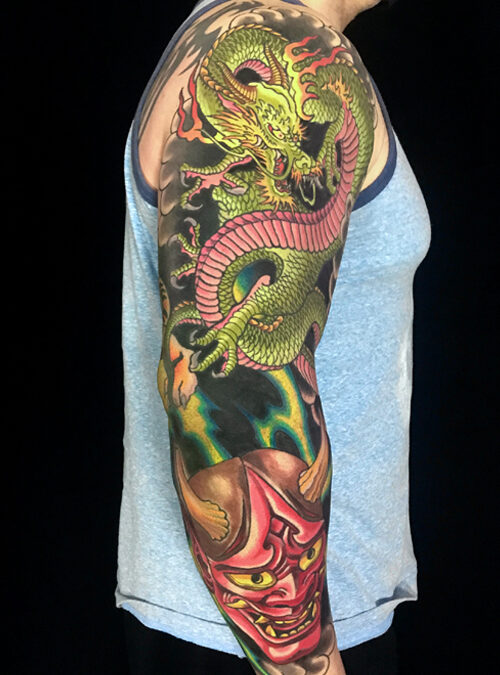Japanese Sleeve Tattoo.
Check out this sneak peek of this custom sleeve.
Done by CanMan of Visions Tattoo Gallery, Medway MA.
To see more works like this, visit our gallery.
Tattooing is the most misunderstood art form in Japan today.
POPULARITY
Today, traditional Japanese motifs, designs, and stylistic sensibilities remain popular sources of inspiration behind many contemporary tattoos.
Often, many artists opt to combine the old with the new.
Creating pieces that range from playful and patterns to delicate works of art.
Regardless of specific style, these Japanese-inspired tattoos have one thing in common: roots in irezumi or traditional Japanese tattooing.
One must first learn about its rich and colorful past.
Thus, to gain an understanding and appreciation for this ancient art form.
Also, the ways in which the Japanese tattoo has evolved over time.
STYLE AND CONTENT
In terms of subject matter, Japanese tattoos often showcase the culture’s reverence for nature.
Nature images include animals and flowers
Many tattoos feature animals associated with strength, courage, and protection—like lions and tigers.
Koi fish are historically popular subjects, too, as they represent luck, success, and good fortune.
Unsurprisingly, cherry blossoms remain the most popular floral motif found in Japanese tattoos.
A flower can carry symbolic meaning.
Also, these short-lived flowers often symbolize ephemerality.
Highly regarded types of flowers in Japan include Lotus, peonies, and Chrysanthemums.
Rrealistic and mythological figures is featured in Japanese tattoos.
Portraits of people often include warriors and geishas, were favored for their expressive faces and bright color..
Additionally, other heroic figures, as well as characters from literature, often appear in Irezumi designs.
TRADITIONAL TO MODERN
Today, Japanese and non-Japanese tattoo artists alike often look to traditional Irezumi for inspiration.
Though the practice has been legal in Japan since 1948, it is still somewhat taboo.
Thus, finding a tattoo shop in the country can sometimes be challenging.
Additionally, Public places are prohibited from entering if your tattooed..
Nevertheless, tattoos have proven popular among Japan’s younger generations.
While many embrace contemporary tools like electric needles, some wish to preserve ancient approaches.
Tebori, or hand-tattooing created using a rod made of either metal or wood.
in addition, It takes considerably longer to render than those made with more modern techniques.
To many tattoo enthusiasts and artists, however, preserving the ancient craft is well worth the extra effort.
